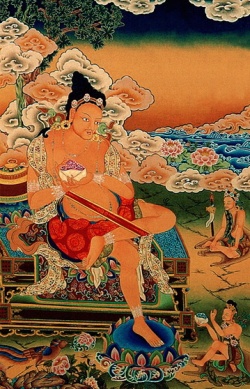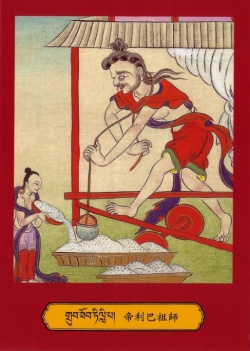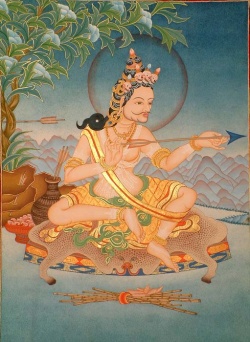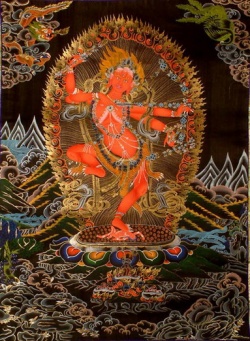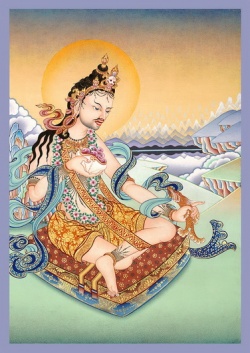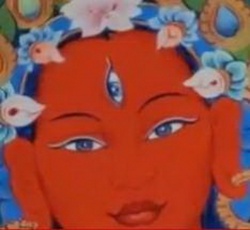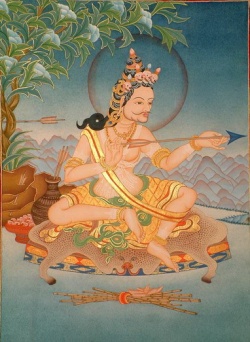Difference between revisions of "Tilopa 989-1069"
| Line 9: | Line 9: | ||
| − | During His visit to Tilokpur [[Monastery]] near {{Wiki|Dharamsala}} in 2007, [[His Holiness]] the Seventeenth [[Gyalwa Karmapa]], [[Ogyen Trinley Dorje]] spoke about [[Tilopa]] and tells us: “In this [[world]] there have been many [[beings]], chiefly [[human beings]], but other [[beings]] as well, who have produced great [[benefit]] by [[offering]] their [[intelligence]], their [[mind]], their talents. [[Tilopa]] was like that. He was able to [[benefit]] an immense number of [[beings]] through his [[realization]] and greatness. For example, if [[medicine]] that can cure a serious {{Wiki|illness}} is kept secret and not given to those who need it, then it will not [[benefit]] anyone. But if that [[medicine]] is spread throughout the [[world]] and made available to everyone, then it will be of great [[benefit]] and will save many [[lives]]. So therefore, in order to understand [[Tilopa’s]] contribution, it is very important to understand what [[realization]] means, the [[wisdom]] that [[Tilopa]] represents. To understand this, we have to look into the story of [[Tilopa]], how he went through difficulties, how much [[effort]] he made, how he [[attained]] [[understanding]], [[wisdom]], and qualities of [[loving kindness]] and [[compassion]].” [[His Holiness]] added: “We understand all those things by looking at [[life]] stories.” | + | During His visit to Tilokpur [[Monastery]] near {{Wiki|Dharamsala}} in 2007, [[His Holiness]] the Seventeenth [[Gyalwa Karmapa]], [[Ogyen Trinley Dorje]] spoke about [[Tilopa]] and tells us: |
| + | |||
| + | “In this [[world]] there have been many [[beings]], chiefly [[human beings]], but other [[beings]] as well, who have produced great [[benefit]] by [[offering]] their [[intelligence]], their [[mind]], their talents. | ||
| + | |||
| + | [[Tilopa]] was like that. He was able to [[benefit]] an immense number of [[beings]] through his [[realization]] and greatness. | ||
| + | |||
| + | For example, if [[medicine]] that can cure a serious {{Wiki|illness}} is kept secret and not given to those who need it, then it will not [[benefit]] anyone. | ||
| + | |||
| + | But if that [[medicine]] is spread throughout the [[world]] and made available to everyone, then it will be of great [[benefit]] and will save many [[lives]]. | ||
| + | |||
| + | So therefore, in order to understand [[Tilopa’s]] contribution, it is very important to understand what [[realization]] means, the [[wisdom]] that [[Tilopa]] represents. | ||
| + | |||
| + | To understand this, we have to look into the story of [[Tilopa]], how he went through difficulties, how much [[effort]] he made, how he [[attained]] [[understanding]], [[wisdom]], and qualities of [[loving kindness]] and [[compassion]].” | ||
| + | |||
| + | [[His Holiness]] added: “We understand all those things by looking at [[life]] stories.” | ||
[[File:Tilopa 1.jpg|thumb|250px|]] | [[File:Tilopa 1.jpg|thumb|250px|]] | ||
| − | [[Tilopa]] was born into a [[Brahmin]] [[family]] in the town of [[Chativavo]] (now called [[Chittagong]] in [[Bangladesh]]). Another text states that he was born in [[Jagora]] ([[East]] {{Wiki|Bengal}}?), that his father’s [[name]] was Pranyasha, and that his mother’s [[name]] was [[Kasi]]. Well heeded and cared for, [[Tilopa]] received the best [[education]] and, in accordance with the {{Wiki|custom}} of his [[caste]], learned all the [[philosophical]] treatises and [[discourses]] of the [[Brahmins]]. A hideously ugly woman [[manifested]] to him at important moments in his [[life]] and, after having inquired about his {{Wiki|status}} and origin when he was still a young boy, she told him: “Your true home is [[Uddiyana]]. Your real father is | + | [[Tilopa]] was born into a [[Brahmin]] [[family]] in the town of [[Chativavo]] (now called [[Chittagong]] in [[Bangladesh]]). |
| + | |||
| + | Another text states that he was born in [[Jagora]] ([[East]] {{Wiki|Bengal}}?), that his father’s [[name]] was [[Pranyasha]], and that his mother’s [[name]] was [[Kasi]]. | ||
| + | |||
| + | Well heeded and cared for, [[Tilopa]] received the best [[education]] and, in accordance with the {{Wiki|custom}} of his [[caste]], learned all the [[philosophical]] treatises and [[discourses]] of the [[Brahmins]]. | ||
| + | |||
| + | A hideously ugly woman [[manifested]] to him at important moments in his [[life]] and, after having inquired about his {{Wiki|status}} and origin when he was still a young boy, she told him: “Your true home is [[Uddiyana]]. Your real father is [[Chakrasamvara]] and your real mother is [[Vajravarahi]].” | ||
| + | |||
| + | Due to her instructions, he entered the way of [[Mahamudra]], the profound [[transmission]] instructions that came from [[Mahasiddha]] [[Saraha]], one of the greatest [[yogis]] of the 8th century, through the [[direct transmission]] of [[Buddha Vajradhara]], the [[Primordial Buddha]] who is not different than the [[historical Buddha]] [[Shakyamuni]]. | ||
| + | |||
| + | The ugly woman who appeared to [[Tilopa]] was in [[truth]] an [[emanation]] of [[Vajrayogini]] (another [[name]] for [[Vajravarahi]]), the [[highest]] [[dakini]] ([[mkha’-‘gro-ma]] in the [[Tibetan language]], which literally means “moving through [[space]]”). | ||
| + | |||
| + | During a seminar at [[Karma Dzong]] in Boulder, Co. in 1988 [[Venerable]] [[Thrangu Rinpoche]] [[taught]] that the best way to understand [[emanations]] like [[Vajrayogini]] or [[Chakrasamvara]] is “to see them as [[dharmata]], ‘the completely vast [[state of emptiness]] that is replete with the [[Buddha’s wisdom]] and has extreme power and [[luminosity]].’ | ||
| + | |||
| + | Due to the very [[nature]] of [[luminosity]] that is [[compassion]] and without [[intention]], that power [[manifests]] to [[benefit]] [[sentient beings]] in {{Wiki|myriad}} different ways – e.g., as [[Vajrayogini]] (the [[essence]] of [[primordial wisdom]]), | ||
| + | |||
| + | or as [[Chakrasamvara]] (the [[essence]] of [[skilful means]] of [[compassion]]), or as a [[king]], or as an [[animal]], or as a [[Wikipedia:Queen consort|queen]], or as a {{Wiki|beggar}}.” | ||
| + | |||
| + | And so, having learned from [[Vajrayogini]] that the [[world]] is [[dharmata]] and full of true meaning, [[Tilopa]] renounced his stately [[life]] and became a [[wandering ascetic]] before he entered the [[monastery]] at [[Somapuri]], | ||
| − | + | where he had the opportunity to learn the “[[Tripitaka]],” the collection of Lord [[Buddha’s teachings]] that are organized into three major [[sections]] and are therefore called “The [[Three Baskets]].” | |
| + | |||
| + | Having become an erudite [[Buddhist scholar]] and exemplary [[monk]], [[Tilopa]] came to be known by the [[name]] [[Prajnabhadra]] ([[prajna]] in [[Sanskrit]] meaning “[[discriminating wisdom-awareness]],” [[shes-rab]] in [[Tibetan]], and [[bhadra]] in [[Sanskrit]] meaning “[[great virtue]]” or “the good one,” [[dzang-po]] in [[Tibetan]]). | ||
[[File:Tilopa.jpg|thumb|250px|]] | [[File:Tilopa.jpg|thumb|250px|]] | ||
| − | + | According to [[Taranatha]] (the prolific early 17th century crown-scholar, writer, and historian of all of [[Tibet]]), [[Tilo Prajnabhadra]] practised with the daughter of a pounder of sesame [[seeds]] and therefore the [[monks]] expelled him from their [[monastery]]. | |
| + | |||
| + | Having lost all his chances for [[wealth]] as a [[Brahmin]] or for a notable position as a [[Buddhist monk]], he pursued the work of a sesame seed pounder in town and it was then that he came to be known as [[Tillipa]], “the sesame pounder” (til meaning “sesame seed”). | ||
| + | |||
| + | He moved on to [[Uddiyana]], the [[pure land]] of [[Guru Rinpoche]], and received various teachings from [[dakinis]]. | ||
| + | |||
| + | He continued to pound sesame [[seeds]] in order to earn his living. B | ||
| + | |||
| + | y working hard, his [[body]] and [[mind]] were also pounded and became balanced. | ||
| + | |||
| + | One day [[Tilo Prajnabhadra]] discovered a text hidden in the base of a [[sacred]] statue. | ||
| + | |||
| + | He prayed to [[Vajrayogini]] to explain its meaning and she advised him to receive instructions on the meaning of the [[tantric text]] from the great [[Mahasiddhas]] of those times. | ||
| + | |||
| + | Following her advice, he travelled extensively in [[India]], going from [[Guru]] to [[Guru]]. | ||
| + | |||
| + | From [[Acharya Nagarjuna]], founder of [[Madhyamaka Philosophy]], he received the “[[Guhyasamaja Tantra]],” the [[illusory body]] and [[radiant light]] teachings ([[sgyu-lüs]] in [[Tibetan]]). | ||
| + | |||
| + | Afterwards [[Nagarjuna]] instructed him to return to his {{Wiki|kingdom}} and assume the [[throne]]. | ||
| + | |||
| + | [[Tilopa]] did and was so powerful that he was able to stop the {{Wiki|Persians}} from attacking his {{Wiki|kingdom}} by miraculously causing the entire {{Wiki|army}} to become blinded by [[blazing light]] and the [[trees]] in the {{Wiki|forest}} to become a huge {{Wiki|army}} of soldiers who defended the territory without spilling any {{Wiki|blood}}. | ||
| + | |||
| + | Continuing his journey in [[India]], from [[Shri Rolpe Dorje]], the [[disciple]] of [[Shri Lawapa]], [[Tilopa]] received the “[[Hevajra Tantra]]” and the [[dream yoga]] ([[rmi-lam]]). | ||
| + | |||
| + | From [[Nampar Gyalwa]] he received the “[[Chakrasamvara Lineage of Luipa]].” | ||
| + | |||
| + | From [[Shavari]], [[disciple of Nagarjuna]] and [[Saraha]], [[Tilopa]] received the complete [[Mahamudra]] instructions. | ||
| + | |||
| + | From [[Acharya]] [[Saryapa]] he received the “[[Inner Heat Yoga Transmission]]” ([[gtum-mo]] in [[Tibetan]]). | ||
| − | + | From [[Sukhasiddhi]], a great {{Wiki|female}} [[master]], he received “[[Pho-ba]],” the [[transference of consciousness]] practice. | |
| + | |||
| + | From [[Shri Matangi]] (according to other sources [[Dakini Matongha]]) [[Tilopa]] received the teachings on {{Wiki|resurrection}} of the [[dead]] [[body]]. | ||
| + | |||
| + | From [[Indrabhuti]] he received the teachings on [[supreme wisdom]] ([[shes-rab]]) as the balancing of the energies. | ||
[[File:Padma-dakini.jpg|thumb|250px|]] | [[File:Padma-dakini.jpg|thumb|250px|]] | ||
| − | |||
| − | [[Tilopa]] devoted himself fully to his practices in the [[western]] area of [[India]] known as [[Somapuri]], the site of one of the greatest [[monastic]] [[universities]] at that time. He practiced for twelve years while he had his feet chained to the walls of his {{Wiki|cave}} so that he could not leave; they broke of themselves after he had achieved some [[realization]] as a result of his diligent [[meditation]]. It should be noted here that while {{Wiki|speaking}} about the [[Dharmapala]] [[tradition]] in [[India]] during his visit to [[Karma | + | Some sources [[state]] that from the [[Wikipedia:Absolute (philosophy)|ultimate]] point of view [[Tilopa]] had no [[human]] [[teachers]] and he received the full [[Mahamudra]] and [[Vajrayana transmissions]] directly from [[Buddha Vajradhara]]. |
| + | |||
| + | [[Venerable]] [[Thrangu Rinpoche]] supports this view and [[taught]] that “[[Buddha Vajradhara]] transmitted directly to certain great [[masters]], but only as a result of the realizations of the teachings they had already received and [[realized]]. | ||
| + | |||
| + | And so, there are two levels in the {{Wiki|biographies}} of [[Tilopa]] that in no way conflict each other.” | ||
| + | |||
| + | [[Thrangu Rinpoche]] tells us that “{{Wiki|biographies}} either show that [[Tilopa]] was a direct [[emanation]] of [[Chakrasamvara]] or they describe him as a normal [[person]] who relied on [[worldly]] [[teachers]] for his {{Wiki|training}}. | ||
| + | |||
| + | Both levels happened simultaneously and have no {{Wiki|chronological}} order. It is quite possible that [[Tilopa]] was receiving direct [[visionary experience]] from [[wisdom dakinis]] while he was searching for or receiving teachings from a [[teacher]] on the [[worldly]] level.” | ||
| + | |||
| + | |||
| + | [[Tilopa]] devoted himself fully to his practices in the [[western]] area of [[India]] known as [[Somapuri]], the site of one of the greatest [[monastic]] [[universities]] at that time. | ||
| + | |||
| + | He practiced for twelve years while he had his feet chained to the walls of his {{Wiki|cave}} so that he could not leave; they broke of themselves after he had achieved some [[realization]] as a result of his diligent [[meditation]]. | ||
| + | |||
| + | It should be noted here that while {{Wiki|speaking}} about the [[Dharmapala]] [[tradition]] in [[India]] during his visit to [[Karma Theksum Tashi Choling]] in [[Hamburg]] in 2007, [[Venerable]] [[Lama Namse]] [[taught]] that | ||
| + | |||
| + | “The most popular [[Dharmapala]] practice that spread within the context of [[Buddhism]] was the [[four-armed Mahakala]], which originated in a [[vision]] that [[Tilopa]] had while practicing in utter [[solitude]] near [[Somapuri]]. | ||
| + | |||
| + | [[Tilopa]] fervently [[meditated]] the [[Chakrasamvara Tantra]] for twelve years.” | ||
| + | |||
| + | The “[[Chakrasamvara Tantra]]” belongs to the [[Father Tantras]] that {{Wiki|emphasize}} the [[creation stage]], whereas the [[Mother Tantras]] {{Wiki|emphasize}} the [[completion stage]] of practice. [[Lama]] [[Namse]] continued: | ||
| + | |||
| + | “During this time, [[Chakrasamvara]] often [[manifested]] to him face to face. | ||
| + | |||
| + | It was during the most advanced stage in [[Tilopa’s]] practice that immense [[hindrances]] arose and subtlest clouds of [[obscurations]] had to be removed. | ||
| + | |||
| + | Therefore [[Chakrasamvara]] [[manifested]] from his [[heart]] the [[four-armed Mahakala]], who [[taught]] [[Tilopa]] supplication and [[offering]] [[prayers]], {{Wiki|syllables}}, and [[mantras]]. | ||
| + | |||
| + | [[Tilopa]] wrote down these instructions and later transmitted them to his most [[worthy]] [[disciples]]. | ||
| + | |||
| + | This was the beginning of [[Dharmapala practice in Vajrayana]].” | ||
[[File:Tilopa21.jpg|thumb|250px|]] | [[File:Tilopa21.jpg|thumb|250px|]] | ||
| − | |||
| − | + | Through his exemplary practice of [[Mahamudra]] and [[Tantra]], [[Tilopa]] [[realized]] co-emergent [[wisdom]] and condensed the [[essence]] of all teachings into four [[principal]] streams of wisdom-teachings. | |
| + | |||
| + | It is from these that the [[Kagyü Tradition]] derives its [[name]], for [[Kagyü]] is an abbreviation of the [[Tibetan]] [[theg-pa-gsum-gyi-snying-dön-bka-bab-kyi-chös-bzhi’i-gdams-ngag-bar-ma-chäd-pa’i-brgyüd-pa]], which roughly means “the unbroken [[lineage]] of profound and intimate guidance in the four sorts of transmitted [[mastery]], the [[heart]] meaning of the [[three yanas]].” | ||
| + | |||
| + | [[Tilopa]] perfectly understood and fully mastered the common and supreme points of all instructions he had received, but [[Guru]] [[Matangi]] (according to [[Thrangu Rinpoche]], the [[dakini]] called [[Karpo Sangmo]]) did not allow him to enter into the [[action]]. | ||
| + | |||
| + | When he showed the [[miracle]] of [[transferring the consciousness]] of a {{Wiki|fish}} into [[space]], his [[preceptor]] knew that he had [[attained]] [[siddhi]] ([[dngös-grub]] in [[Tibetan]], which means “[[accomplishment]]”) and let him go wherever he wanted so that he could [[benefit]] many, many [[living beings]]. | ||
| + | |||
| + | In order to rid [[Tilopa]] of his last traces of [[pride]], his [[Guru]] [[Shri]] [[Matangi]] told him to work at a brothel in {{Wiki|Bengal}} for a [[prostitute]] called [[Dharima]]. | ||
| + | |||
| + | At night he assisted the [[prostitute]] by escorting men in and out; during the day he did the work of beating sesame [[seeds]] for his living. | ||
| + | |||
| + | He had begun [[teaching]] and passed on what he had [[realized]] in the [[form]] of [[songs]] to large gatherings in towns. | ||
| + | |||
| + | He flew into the sky, and through his power [[caused]] [[Dharima]] to likewise [[experience]] [[realization]]. | ||
| + | |||
| + | The [[king]] of the area in {{Wiki|Bengal}} and the entire population witnessed this marvel and felt deep [[devotion]]. | ||
| + | |||
| + | On that occasion, hundreds of thousands of [[people]] came to see [[Tilopa]] together with his [[consort]] in the sky while pounding sesame [[seeds]]. | ||
| + | |||
| + | When students in the audience asked questions, [[Tilopa]] put his [[experiences]] into a [[doha]], answering each question in this way. | ||
| + | |||
| + | [[Mahamudra]] is [[taught]] through the method of [[dohas]], “[[pith]] [[spiritual]] [[songs]].” | ||
| + | |||
| + | [[Dohas]] do not give a detailed presentation of [[Buddhism]] but use {{Wiki|practical}} [[imagery]] to introduce students to the [[true nature]] of their [[mind]]. | ||
| − | + | The song that he composed and [[sang]] at the crossroads of the marketplace in the town in {{Wiki|Bengal}} is: | |
[[File:Ges976789.jpg|thumb|250px|]] | [[File:Ges976789.jpg|thumb|250px|]] | ||
| − | + | “{{Wiki|Sesame}} oil is the [[essence]]. | |
| + | |||
| + | Although the [[ignorant]] know that it is in the sesame seed, they do not understand the way of [[cause]], effect, and becoming, and therefore are not able to extract the [[essence]], the sesame oil. | ||
| + | |||
| + | Although innate coemergent [[wisdom]] abides in the [[heart]] of all [[beings]], if it is not shown by the [[Guru]], it cannot be [[realized]]. | ||
| + | |||
| + | Just like sesame oil that remains in the seed, it does not appear. | ||
| + | |||
| + | One removes the husk by beating the sesame, and the sesame oil, the [[essence]], appears. In the same way, the [[Guru]] shows the [[truth]] of [[Tathata]], and all [[phenomena]] become indivisible in one [[essence]]. Kye ho! | ||
| + | |||
| + | The far-reaching, unfathomable meaning is apparent at this very [[moment]]. O how wondrous!” | ||
| − | + | It is said that all those who were assembled were {{Wiki|liberated}} from the bondage of afflicting [[emotions]] and [[attained]] [[realization]] just by hearing [[Tilopa]] sing this song. | |
| − | + | And so, [[Tilopa]] became renowned as the [[Siddha]] [[Tilopa]] and is one of the [[eighty-four Mahasiddhas]] of [[India]] who benefited [[beings]] immensely and guided his eight main [[spiritual]] sons and many [[disciples]] for a long time. | |
| + | |||
| + | He transmitted the entire instructions he received and [[realized]] directly to his most {{Wiki|eminent}} [[student]], [[Mahapandita]] [[Nadapada]], better known as [[Naropa]], and composed his most direct pointing-out instructions addressing him in a song that he [[sang]] on the banks of the [[Ganges River]], entitled “[[Ganga]]-[[Mahamudra]]-[[Upadesha]]. | ||
| + | |||
| + | The [[Ganges River]] [[Pith Instruction]] on [[Mahamudra]].” A few selected verses: | ||
[[File:Tilopa4.jpg|thumb|250px|]] | [[File:Tilopa4.jpg|thumb|250px|]] | ||
| + | |||
“Homage to the [[Vajradakini]]. | “Homage to the [[Vajradakini]]. | ||
| − | + | Although [[Mahamudra]] cannot be [[taught]], {{Wiki|intelligent}} and {{Wiki|patient}} [[Naropa]], tolerant of [[suffering]], who is engaged in austerity and is devoted to the [[Guru]], [[fortunate]] one, do this with your [[mind]]. | |
| + | |||
| + | In one’s [[mind]], [[Mahamdura]], there is nothing to be shown. Rest [[relaxed]] in the natural [[state]] without attempting to alter anything. If this [[fetter]] or bondage of [[thought]] is loosened, there is no [[doubt]] that you will be {{Wiki|liberated}}. | ||
| + | |||
| + | If free of all [[intention]] and you do not abide in extremes, you will see without exception the meaning of all the [[Buddha’s teachings]]. | ||
| + | |||
| + | Wishing to attain [[liberation]] from intolerable [[suffering]], rely upon a [[wise]] [[Guru]]. | ||
| + | |||
| + | When the [[Guru’s]] [[blessings]] enter your [[heart]], your [[mind]] will be {{Wiki|liberated}}. | ||
| + | |||
| + | Cut through the bonds of [[attachment]] and [[aversion]] (…). [[Meditate]] in isolated [[retreats]], forests, and so forth, living alone. Remain in that [[state]] without [[meditation]]. | ||
| + | |||
| + | When you attain that which is without [[attainment]], you have [[attained]] [[Mahamudra]]. | ||
| + | |||
| + | For example, just as the {{Wiki|darkness}} that has [[accumulated]] over thousands of [[aeons]] is dispelled by the [[illumination]] of one [[lamp]] or one torch, in the same way, | ||
| + | |||
| + | one instant of the [[wisdom]] of the [[clear light]] of one’s [[mind]] dispels all the [[ignorance]], wrongdoing, and [[obscurations]] [[accumulated]] throughout numerous [[aeons]]. | ||
| + | |||
| + | Kye ho! [[Complete liberation]] from all {{Wiki|conceptual}} extremes is the supreme {{Wiki|monarch}} of [[views]]. [[Boundless]] vastness is the supreme {{Wiki|monarch}} of [[meditations]]. | ||
| + | |||
| + | Being utterly impartial is the supreme {{Wiki|monarch}} of conduct. [[Self-liberation]] beyond expectation or {{Wiki|hope}} is the supreme result.” | ||
| + | |||
| − | + | [[His Holiness]] the [[Gyalwa Karmapa]] concluded his teachings about [[Mahasiddha Tilopa]] in 2007 by telling us that [[Tilopa]] had given his [[clothes]] to a {{Wiki|beggar}} | |
| − | + | who was riddled with lice and in exchange took the beggar’s cape and wore it so that the lice in it had the chance to feed on his [[body]] and not [[die]]. | |
| − | + | [[Seeing]] that [[Tilopa]] was getting weaker until he got sick, his students beseeched him to rid his [[body]] of the lice. | |
| − | + | [[Tilopa]] told his [[disciples]] that he had wasted so many [[lives]] and said: | |
| − | + | “This is the time that I am using this [[life]] and this [[body]] to help others. | |
| − | + | My [[life]] has become meaningful. | |
| − | + | Even if I [[die]], I will think that I have used my [[life]] in the most beneficial way, so I will not change. I will not give up.” It is recorded that he departed for the [[enlightened]] [[realms]] without leaving his [[physical body]]. | |
| − | / shes-rab-gsum-gyi-snang-ba-rgyäs-par-shog // | + | / [[shes-rab-gsum-gyi-snang-ba-rgyäs-par-shog]] // |
May the [[three kinds of wisdom-awareness]] flourish and expand! | May the [[three kinds of wisdom-awareness]] flourish and expand! | ||
Latest revision as of 20:09, 27 January 2016
“In the west, in Uddiyana, the secret treasure ground of the dakinis,
The great siddha Tilo opened the treasure of the three gems.”
-- Jamgon Kongtrul Lodrö Thaye the Great, The Song of Lodrö Thaye
During His visit to Tilokpur Monastery near Dharamsala in 2007, His Holiness the Seventeenth Gyalwa Karmapa, Ogyen Trinley Dorje spoke about Tilopa and tells us:
“In this world there have been many beings, chiefly human beings, but other beings as well, who have produced great benefit by offering their intelligence, their mind, their talents.
Tilopa was like that. He was able to benefit an immense number of beings through his realization and greatness.
For example, if medicine that can cure a serious illness is kept secret and not given to those who need it, then it will not benefit anyone.
But if that medicine is spread throughout the world and made available to everyone, then it will be of great benefit and will save many lives.
So therefore, in order to understand Tilopa’s contribution, it is very important to understand what realization means, the wisdom that Tilopa represents.
To understand this, we have to look into the story of Tilopa, how he went through difficulties, how much effort he made, how he attained understanding, wisdom, and qualities of loving kindness and compassion.”
His Holiness added: “We understand all those things by looking at life stories.”
Tilopa was born into a Brahmin family in the town of Chativavo (now called Chittagong in Bangladesh).
Another text states that he was born in Jagora (East Bengal?), that his father’s name was Pranyasha, and that his mother’s name was Kasi.
Well heeded and cared for, Tilopa received the best education and, in accordance with the custom of his caste, learned all the philosophical treatises and discourses of the Brahmins.
A hideously ugly woman manifested to him at important moments in his life and, after having inquired about his status and origin when he was still a young boy, she told him: “Your true home is Uddiyana. Your real father is Chakrasamvara and your real mother is Vajravarahi.”
Due to her instructions, he entered the way of Mahamudra, the profound transmission instructions that came from Mahasiddha Saraha, one of the greatest yogis of the 8th century, through the direct transmission of Buddha Vajradhara, the Primordial Buddha who is not different than the historical Buddha Shakyamuni.
The ugly woman who appeared to Tilopa was in truth an emanation of Vajrayogini (another name for Vajravarahi), the highest dakini (mkha’-‘gro-ma in the Tibetan language, which literally means “moving through space”).
During a seminar at Karma Dzong in Boulder, Co. in 1988 Venerable Thrangu Rinpoche taught that the best way to understand emanations like Vajrayogini or Chakrasamvara is “to see them as dharmata, ‘the completely vast state of emptiness that is replete with the Buddha’s wisdom and has extreme power and luminosity.’
Due to the very nature of luminosity that is compassion and without intention, that power manifests to benefit sentient beings in myriad different ways – e.g., as Vajrayogini (the essence of primordial wisdom),
or as Chakrasamvara (the essence of skilful means of compassion), or as a king, or as an animal, or as a queen, or as a beggar.”
And so, having learned from Vajrayogini that the world is dharmata and full of true meaning, Tilopa renounced his stately life and became a wandering ascetic before he entered the monastery at Somapuri,
where he had the opportunity to learn the “Tripitaka,” the collection of Lord Buddha’s teachings that are organized into three major sections and are therefore called “The Three Baskets.”
Having become an erudite Buddhist scholar and exemplary monk, Tilopa came to be known by the name Prajnabhadra (prajna in Sanskrit meaning “discriminating wisdom-awareness,” shes-rab in Tibetan, and bhadra in Sanskrit meaning “great virtue” or “the good one,” dzang-po in Tibetan).
According to Taranatha (the prolific early 17th century crown-scholar, writer, and historian of all of Tibet), Tilo Prajnabhadra practised with the daughter of a pounder of sesame seeds and therefore the monks expelled him from their monastery.
Having lost all his chances for wealth as a Brahmin or for a notable position as a Buddhist monk, he pursued the work of a sesame seed pounder in town and it was then that he came to be known as Tillipa, “the sesame pounder” (til meaning “sesame seed”).
He moved on to Uddiyana, the pure land of Guru Rinpoche, and received various teachings from dakinis.
He continued to pound sesame seeds in order to earn his living. B
y working hard, his body and mind were also pounded and became balanced.
One day Tilo Prajnabhadra discovered a text hidden in the base of a sacred statue.
He prayed to Vajrayogini to explain its meaning and she advised him to receive instructions on the meaning of the tantric text from the great Mahasiddhas of those times.
Following her advice, he travelled extensively in India, going from Guru to Guru.
From Acharya Nagarjuna, founder of Madhyamaka Philosophy, he received the “Guhyasamaja Tantra,” the illusory body and radiant light teachings (sgyu-lüs in Tibetan).
Afterwards Nagarjuna instructed him to return to his kingdom and assume the throne.
Tilopa did and was so powerful that he was able to stop the Persians from attacking his kingdom by miraculously causing the entire army to become blinded by blazing light and the trees in the forest to become a huge army of soldiers who defended the territory without spilling any blood.
Continuing his journey in India, from Shri Rolpe Dorje, the disciple of Shri Lawapa, Tilopa received the “Hevajra Tantra” and the dream yoga (rmi-lam).
From Nampar Gyalwa he received the “Chakrasamvara Lineage of Luipa.”
From Shavari, disciple of Nagarjuna and Saraha, Tilopa received the complete Mahamudra instructions.
From Acharya Saryapa he received the “Inner Heat Yoga Transmission” (gtum-mo in Tibetan).
From Sukhasiddhi, a great female master, he received “Pho-ba,” the transference of consciousness practice.
From Shri Matangi (according to other sources Dakini Matongha) Tilopa received the teachings on resurrection of the dead body.
From Indrabhuti he received the teachings on supreme wisdom (shes-rab) as the balancing of the energies.
Some sources state that from the ultimate point of view Tilopa had no human teachers and he received the full Mahamudra and Vajrayana transmissions directly from Buddha Vajradhara.
Venerable Thrangu Rinpoche supports this view and taught that “Buddha Vajradhara transmitted directly to certain great masters, but only as a result of the realizations of the teachings they had already received and realized.
And so, there are two levels in the biographies of Tilopa that in no way conflict each other.”
Thrangu Rinpoche tells us that “biographies either show that Tilopa was a direct emanation of Chakrasamvara or they describe him as a normal person who relied on worldly teachers for his training.
Both levels happened simultaneously and have no chronological order. It is quite possible that Tilopa was receiving direct visionary experience from wisdom dakinis while he was searching for or receiving teachings from a teacher on the worldly level.”
Tilopa devoted himself fully to his practices in the western area of India known as Somapuri, the site of one of the greatest monastic universities at that time.
He practiced for twelve years while he had his feet chained to the walls of his cave so that he could not leave; they broke of themselves after he had achieved some realization as a result of his diligent meditation.
It should be noted here that while speaking about the Dharmapala tradition in India during his visit to Karma Theksum Tashi Choling in Hamburg in 2007, Venerable Lama Namse taught that
“The most popular Dharmapala practice that spread within the context of Buddhism was the four-armed Mahakala, which originated in a vision that Tilopa had while practicing in utter solitude near Somapuri.
Tilopa fervently meditated the Chakrasamvara Tantra for twelve years.”
The “Chakrasamvara Tantra” belongs to the Father Tantras that emphasize the creation stage, whereas the Mother Tantras emphasize the completion stage of practice. Lama Namse continued:
“During this time, Chakrasamvara often manifested to him face to face.
It was during the most advanced stage in Tilopa’s practice that immense hindrances arose and subtlest clouds of obscurations had to be removed.
Therefore Chakrasamvara manifested from his heart the four-armed Mahakala, who taught Tilopa supplication and offering prayers, syllables, and mantras.
Tilopa wrote down these instructions and later transmitted them to his most worthy disciples.
This was the beginning of Dharmapala practice in Vajrayana.”
Through his exemplary practice of Mahamudra and Tantra, Tilopa realized co-emergent wisdom and condensed the essence of all teachings into four principal streams of wisdom-teachings.
It is from these that the Kagyü Tradition derives its name, for Kagyü is an abbreviation of the Tibetan theg-pa-gsum-gyi-snying-dön-bka-bab-kyi-chös-bzhi’i-gdams-ngag-bar-ma-chäd-pa’i-brgyüd-pa, which roughly means “the unbroken lineage of profound and intimate guidance in the four sorts of transmitted mastery, the heart meaning of the three yanas.”
Tilopa perfectly understood and fully mastered the common and supreme points of all instructions he had received, but Guru Matangi (according to Thrangu Rinpoche, the dakini called Karpo Sangmo) did not allow him to enter into the action.
When he showed the miracle of transferring the consciousness of a fish into space, his preceptor knew that he had attained siddhi (dngös-grub in Tibetan, which means “accomplishment”) and let him go wherever he wanted so that he could benefit many, many living beings.
In order to rid Tilopa of his last traces of pride, his Guru Shri Matangi told him to work at a brothel in Bengal for a prostitute called Dharima.
At night he assisted the prostitute by escorting men in and out; during the day he did the work of beating sesame seeds for his living.
He had begun teaching and passed on what he had realized in the form of songs to large gatherings in towns.
He flew into the sky, and through his power caused Dharima to likewise experience realization.
The king of the area in Bengal and the entire population witnessed this marvel and felt deep devotion.
On that occasion, hundreds of thousands of people came to see Tilopa together with his consort in the sky while pounding sesame seeds.
When students in the audience asked questions, Tilopa put his experiences into a doha, answering each question in this way.
Mahamudra is taught through the method of dohas, “pith spiritual songs.”
Dohas do not give a detailed presentation of Buddhism but use practical imagery to introduce students to the true nature of their mind.
The song that he composed and sang at the crossroads of the marketplace in the town in Bengal is:
“Sesame oil is the essence.
Although the ignorant know that it is in the sesame seed, they do not understand the way of cause, effect, and becoming, and therefore are not able to extract the essence, the sesame oil.
Although innate coemergent wisdom abides in the heart of all beings, if it is not shown by the Guru, it cannot be realized.
Just like sesame oil that remains in the seed, it does not appear.
One removes the husk by beating the sesame, and the sesame oil, the essence, appears. In the same way, the Guru shows the truth of Tathata, and all phenomena become indivisible in one essence. Kye ho!
The far-reaching, unfathomable meaning is apparent at this very moment. O how wondrous!”
It is said that all those who were assembled were liberated from the bondage of afflicting emotions and attained realization just by hearing Tilopa sing this song.
And so, Tilopa became renowned as the Siddha Tilopa and is one of the eighty-four Mahasiddhas of India who benefited beings immensely and guided his eight main spiritual sons and many disciples for a long time.
He transmitted the entire instructions he received and realized directly to his most eminent student, Mahapandita Nadapada, better known as Naropa, and composed his most direct pointing-out instructions addressing him in a song that he sang on the banks of the Ganges River, entitled “Ganga-Mahamudra-Upadesha.
The Ganges River Pith Instruction on Mahamudra.” A few selected verses:
“Homage to the Vajradakini.
Although Mahamudra cannot be taught, intelligent and patient Naropa, tolerant of suffering, who is engaged in austerity and is devoted to the Guru, fortunate one, do this with your mind.
In one’s mind, Mahamdura, there is nothing to be shown. Rest relaxed in the natural state without attempting to alter anything. If this fetter or bondage of thought is loosened, there is no doubt that you will be liberated.
If free of all intention and you do not abide in extremes, you will see without exception the meaning of all the Buddha’s teachings.
Wishing to attain liberation from intolerable suffering, rely upon a wise Guru.
When the Guru’s blessings enter your heart, your mind will be liberated.
Cut through the bonds of attachment and aversion (…). Meditate in isolated retreats, forests, and so forth, living alone. Remain in that state without meditation.
When you attain that which is without attainment, you have attained Mahamudra.
For example, just as the darkness that has accumulated over thousands of aeons is dispelled by the illumination of one lamp or one torch, in the same way,
one instant of the wisdom of the clear light of one’s mind dispels all the ignorance, wrongdoing, and obscurations accumulated throughout numerous aeons.
Kye ho! Complete liberation from all conceptual extremes is the supreme monarch of views. Boundless vastness is the supreme monarch of meditations.
Being utterly impartial is the supreme monarch of conduct. Self-liberation beyond expectation or hope is the supreme result.”
His Holiness the Gyalwa Karmapa concluded his teachings about Mahasiddha Tilopa in 2007 by telling us that Tilopa had given his clothes to a beggar
who was riddled with lice and in exchange took the beggar’s cape and wore it so that the lice in it had the chance to feed on his body and not die.
Seeing that Tilopa was getting weaker until he got sick, his students beseeched him to rid his body of the lice.
Tilopa told his disciples that he had wasted so many lives and said:
“This is the time that I am using this life and this body to help others.
My life has become meaningful.
Even if I die, I will think that I have used my life in the most beneficial way, so I will not change. I will not give up.” It is recorded that he departed for the enlightened realms without leaving his physical body.
/ shes-rab-gsum-gyi-snang-ba-rgyäs-par-shog //
May the three kinds of wisdom-awareness flourish and expand!
